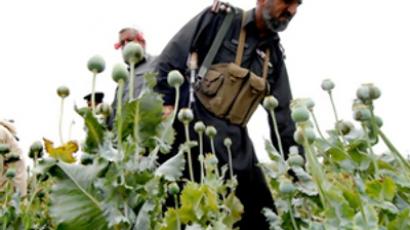The monkey on Russia’s back
At least 80 people die of heroin abuse in Russia every day, with the vast majority of supplies coming from Afghanistan.
Though Moscow and Kabul have agreed to take joint action to halt the drugs tsunami rolling in from Afghanistan, the opium production in the region continues to grow, so Moscow has also offered to work with NATO and the US to stem the tide.
“I must constantly spend enormous amounts of money on drugs in order to feel well,” says drug addict Anna Kharitonova who has been hooked on heroin for seven years. She has to inject herself at least six times a day.
She has already been hospitalized nine times. Now she looks for salvation at a special religious centre in Moscow. She is one of many who come for spiritual advice and to pray for strength.
“I am spending it on destroying my health and body and it’s only now I’ve come to realize that, and it’s only now that I’ve come to the church to look for salvation. To be frank, it’s my last hope.”
Russia is one the biggest consumers of illegal drugs. Out of the estimated two million heroin addicts in Russia, most are hooked on opiates which originate in the poppy fields of Afghanistan.
The drugs are brought to Russia through Central Asia. Once the heroin is manufactured, it’s virtually impossible to stop it getting through the vast 7,500 km border with Kazakhstan.
“A one kilo package of concentrated heroin holds more than 200,000 injections. Packages bear the brands of Afghan drug cartels. We made a special pack of cards, which has 180 cards with the brands of cartels in Afghanistan. Together they produce 1000 tons of heroin annually,” informs the Head of Russia's Anti-Narcotics Service Victor Ivanov.
Russian officials are asking the international community to help, as Afghanistan produces 94% of the world's heroin.
“Since the moment NATO forces entered the country, production increased forty-fold,” continues Ivanov.
The Head of Russia's Anti-Narcotics Service also added that “Today, Afghanistan has the monopoly on heroin. We call for NATO to fulfill its responsibilities in managing the region – including fighting drugs.”
Priest and advisor of the religious rehabilitation centre in Moscow Aleksandr Sergienko said “It’s like an iceberg. We see the top but we have no idea of what goes on underneath. The drug addicts who come here say to me: ‘Aleksandr, you simply don’t know how many of us there really are.’ It’s a state and social problem.”
Workers at the Moscow rehab centre say they are overwhelmed with the number of people who ask for their help. In Russia at least 30,000 people die each year due to drugs. In a country with a shrinking population it’s a statistic it could well do without.
A long term strategy focusing on border patrol and law enforcement must be enacted says drug expert, Vyacheslav Scherbakov from the University of Interior Ministry.
"Heroin problem in Russia cannot be solved in 1-2 years," said Scherbakov.













